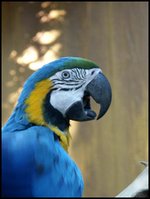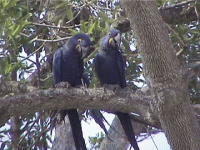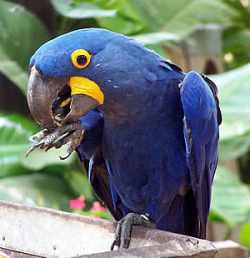Below, advertising


|
The Blue Macaw Project
Saving Species Endangered by Illegal Trafficking: The Arara Azul Project
By Neiva Maria Robaldo Guedes.
UNIDERP Arara Azul Project Coordinator.
The essay below was originally published by the Brazilian Ministry of Foreigner Relations. The text was adapted for publication on the internet.
"An anonymous phone call made to the Environmental Police reports on the screeches of macaws heard coming from a small hotel next to the Campo Grande bus station. Three officers are dispatched to the scene, where they conduct an inspection of the area. After concluding their search and concerned about not finding anything, they suddenly hear the vocalizations of macaw chicks. They open the door to a room where two men are trying to hide a small box under the bed. In the box, there are three Hyacinth macaw chicks (Anodorhynchus
hyacinthinus) and six adult arajubas
(Guaruba guarouba)."
The seizure, carried out on February 12th, 2004, was the most recent in Mato Grosso
do Sul.
Arajubas, however, are not found in the state, and as the deputy filled out the Case Report, he discovered that the birds had come from Maranhão. Despite the fact that the men had traveled long distances with the macaws vocalizing and screeching, had passed along the way by police stations and come into contact
with a great number of people, no one had seen fit to report their activities. The journey,
which would surely have continued on to Bolivia and from there to other parts of the world, was cut short in Campo Grande.
 Giant Blue Macaw
Photo: Wikipedia
This is but one of the achievements of the Projeto Arara Azul (Blue Macaw Project), which has sought since its inception to involve and educate the human population with respect to the preservation
of the Hyacinth macaw, a specie that was in the process of disappearing mainly as a result of intense trafficking activities through the 1980s, up to which time, it is estimated, more than 10,000 individuals were removed from their natural habitat.
Macaws and parrots are among the most impressive specimens of tropical avifauna.
Because of their beauty, marked by their brightly colored feathers, the ease with which they adapt to captivity, and their ability to imitate speech and interact with the human
population, the Psittacidae family (macaws,
parakeets, and parrots) represent one of the most endangered species on earth.
The interest in macaws is long-standing. Indeed, several centuries ago they were already regularly
captured to serve as pets and have their feathers used as ornaments.
The Hyacinth macaw is the largest member of the Psittacidae family, reaching 1 meter (3.3 ft) in height and 1.3 kilograms (2.8 lb.) in weight. It is distinguished by an inclining cobalt blue color from its head to the tip of its tail. The blue coloring of its body contrasts with the bright yellow of the ring-shaped skin around its eyes and the thin strip of skin surrounding its bill. The inside portion of the feathers on its wings and tail are black, which explains the origin of ararauna or black macaw (as they are called by the indigenous populations).
Included on the list of Brazilian Endangered Fauna (Fauna Brasileira Ameaçada
de Extinção) and appendix I of CITES, the Hyacinth macaw's population dwindled as a consequence of three main factors: its capture for sale on the domestic and international
markets, the destruction of its habitat, and the harvesting of its feathers for use as indigenous ornaments.
This situation b
egan to change in Mato Grosso do Sul with the establishment of the Arara
Azul Project, in 1990. The Project consists in studies on the basic biology, management, and preservation of the Hyacinth macaw (Andorhynchus
hyacinthinus) in its natural habitat.
The principal objective of the Arara Azul Project is to preserve a viable population of Hyacinth macaws in the wild, free of the risk of extinction in the medium and long terms. In practice, the strategy and measures aimed at preserving or managing the species in its habitat will benefit other species that share the same environment.
The initial results of our research indicated
that the species have highly specialized feeding habits.
In each location: the Pantanal
(which includes the states of Mato Grosso do Sul, Mato Grosso, and a small part of Bolivia
and Paraguay), Amazonia (basically the state of Pará), and the Gerais region, where the states of Tocantins, Piauí, Maranhão, and Bahia converge, Hyacinth macaws are specialized
in eating the nuts from two types of palms.
In the Pantanal, they overwhelmingly consume the acuri nut (Scheelea phalerata) and bocaiúva nut (Acrocomia aculeata). All other sources of food account for less than 5% of their diet.
Hyacinth macaws have sedentary lives. In other words, they are resident species, insofar
as they can be found in the areas they inhabit for most of the year and do not tend toward long migrations. They are also social birds; that is, they live in families, bands, or groups and are highly conspicuous (they display
curiosity, vocalize, and flaunt themselves).
Hyacinth macaws have low reproductive rates. The majority of couples lay an average of two eggs, yet generally only one chick survives, which is then raised by its parents for a year and a half. In addition, most couples only reproduce
every two years.
In the Pantanal, Hyacinth macaws use tree cavities to reproduce. These can be identified
through loose feathers scattered on the ground below, pieces of coconut found under the trees, the presence of macaws, eggs, or chicks. The tree cavities, which are designated nests, are recorded and monitored on a regular
basis.
Through January 2004, 346 natural and 178 artificial box nests were registered in an area covering approximately 400,000 hectares (988,000 acres) encompassing 45 ranches in 5 sub-regions of the Pantanal Sul: Nhecolândia, Abobral, Miranda, Aquiduana, and Rio Negro.
The results of our surveys revealed that 90% of the nests that we uncovered are located in a single arboreal species, the local name for which is manduvi (Sterculia apetala). Our findings showed that there is a lack of large tree cavities for Hyacinth macaws and other species that also use tree cavities to reproduce.
In short, the Hyacinth macaw depends on the manduvi, which is key to its survival in the Pantanal. For this reason and also because
of the large amount of time required for the tree to grow and their importance to other species as a source of shade, shelter, nests, and food, we have encouraged rural laborers
and farmers to protect young plants and replant manduvis.
At the same time, we tested various models and materials for artificial box nests in order to increase the supply of cavities.
In 1997 and 1998, we installed 150 artificial box nests primarily in the "Pantanal de Miranda", the area suffering from the largest shortage of nests. The results were surprising. More than fifty percent of the nests were immediately exploited by the Hyacinth macaws, while eggs were laid in their artificial box nests. However, the other species that compete for natural tree cavities, such as the wild duck (Cairina moschata),
the owl (Tyto alba), the parrot (Amazona
aestiva), the toucan (Ramphastos toco), and various species of hawks, occupied the majority of the artificial box nests. This provided
a larger number of natural nests for the Hyacinth macaws, whose chicks registered a survival rate exceeding 200%.
Other activities performed by the Arara Azul Project to increase the supply of nests include
the management and recovery of natural
and artificial box nests.
Our findings show that 3 to 5% of all natural nests are lost due to climate-related conditions such as rain and wind, as well as fire and deforestation. However,
in light of the fact that Hyacinth macaws reuse their nests for several years (some nests were used over a period of twelve consecutive years), the loss of one nest represents a significant
loss for the population, which already suffers from a shortage of nests. Therefore, our efforts have been directed toward recovering
those nests that are in the process of decaying.
Tree cavities with excessively large apertures that allow predators or rain to enter are managed with a view to reducing the size of the aperture. The base of nests that are too deep, and therefore difficult for macaw chicks to exit, are elevated with twigs and sawdust or by opening a cavity closer to the base of the nest.
Nests subject to flooding, which results in the death of macaw chicks or the abandonment of eggs as a result of the inundation,
are drained.
Meanwhile, damaged artificial
box nests are repaired and/or replaced.
To illustrate the results of these efforts, eighty two nests were recovered or introduced in the "Pantanal Sul" (Southern Pantanal), in 2002.
Of these, eighty percent
were immediately reused, while successful
births of macaw chicks were detected in the majority of the 29 natural nests.
In 2000, we undertook, with the approval
of the Committee for the Management and Preservation of the Hyacinth Macaw, coordinated
by IBAMA, macaw egg and chick management efforts.
The objective of these activities was to develop and test a management
technique that could be used in the future should the need arise. Thus, the eggs in those
nests that had historically been vulnerable to predators were collected and replaced with wood imitations (which were not accepted) or small chicken eggs (one hundred percent of which were accepted).
The Hyacinth macaw eggs were taken for artificial incubation, while the replacement eggs were hatched in the nests. Following their birth, the Hyacinth macaw
chicks were returned to their nests and raised by their parents.
On a different front, we cared for the second macaw chick, which is usually born four to five days after the first chick and does not, in most cases, survive.
In these cases, we removed the macaw chick from its nest, fed it in a laboratory for five to seven days, and returned it to its original nest or to a nest containing two macaw chicks in the same situation, whereupon the macaw chick was exchanged for the vulnerable macaw
chick. We placed the two oldest macaw chicks in one nest and the two youngest in another.
Our findings demonstrated that Hyacinth
macaws readily accept this interference, thereby allowing us to increase the number of couples able to secure the survival of both macaw chicks.
Prior to taking flight, the Hyacinth macaw
chicks are weighed, measured, tagged, fitted with a microchip, and have a small blood sample drawn for determination of their sex and analysis of their DNA at the University of São Paulo (USP). This has enabled a series of overlapping genetic research studies to be conducted that have led to numerous Masters' thesis and PHD dissertations (Miyaki et al. 1999).
In addition, the fact that we have access
to several nests and monitor chicks from their birth through their 3rd or 4th month of life has allowed us to track their health, perform studies of diseases, and obtain knowledge and conduct analyses of ecto- and endoparasites.
To this end, the researchers involved in these efforts, mainly veterinarians, have contributed
to our work by identifying a series of events that affect Hyacinth macaws and Psittacidae
family members overall in their natural
habitat.
New findings have demonstrated the presence of Salmonella bredney (Vilela et al. 2001) and Chlamydophila psittaci (Raso et al. 2003).
We have taken advantage of the implementation
of our field work to provide information
to residents, laborers, and farmers in order to educate and involve them in preservation
efforts.
Today, we can state that this has represented one of the major accomplishments
of our Project, for local residents know where nests, eggs, and chicks are located and therefore can help monitor and protect them. When chicks fall in their initial attempts at flight, the Project's team is immediately called to recover and return them to their nests. Chicks are not taken to serve as pets or sold, even those found in nests located near homes, roads, and/or with easily accessible apertures.
The Project's permanent presence has led to a change in the population's attitudes,
to the extent that most people want to see the Hyacinth macaw flying freely over the Pantanal.
This also has had the effect of encouraging
ecotourism as an alternative form of income for landowners. In the "Pousada Araruna"
and the "Refúgio Ecológico Caiman", where our base camps are located, tourists attend lectures by biologists and field assistants,
and small groups of guests have the opportunity to view the Project team’s work firsthand.
Therefore, we believe that the results achieved and the experiments performed with the Hyacinth macaw of the Pantanal can serve as a reference for the preservation of other declining blue macaw populations, such as the Lear's blue macaw (Anodorhynchus leari), with close to 450 individuals located in Bahia, and the little blue macaw (Cyanopsitta spixii), the last known wild specimen of which disappeared
in November 2000, leaving only 60 individuals in captivity scattered around the world.
In fact, the Arara Azul Project has become
an example internationally for the preservation
of endangered species, especially members of the Psittacidae family, and has served as a gauge for projects launched from Mexico to the southern tip of Latin America.
With specific regard to the species in question, the results have been significant given
that in the Pantanal, at least, and primarily
Mato Grosso do Sul, the Hyacinth macaw population has been recovered and the collection
and trafficking of individuals reduced, if not yet totally eradicated.
Estimates in 1987 placed the total number of Hyacinth macaw individuals in the Pantanal at 1,500, whereas today we estimate
that population to stand at 4,000 just in Mato Grosso do Sul's portion of the Pantanal. The Hyacinth macaw population is not only increasing but is also expanding to other regions,
such as the Bolivian and Paraguayan Pantanal. We can expect Hyacinth macaws to continue inhabiting the Pantanal into the future.
Indeed, were it not for ongoing illegal trafficking in other areas in which the species is found, such as Northeastern Brazil, as well as the harvesting of feathers by indigenous communities in the North of Brazil, we could expect the species to be removed from the endangered list in the coming years.
In conclusion, the presence of the Hyacinth
macaw does not only benefit the species, but the population of the Pantanal, other species
that share its habitat, and all of humanity, as well, for after all a unique environment is being preserved, the Pantanal, a common heritage of humanity.
Lastly, we would like to thank UNIDERP – Universidade para o Desenvolvimento do Estado e Região do Pantanal (University for the Development of the State and Region of the Pantanal), FMB, WWF of Brazil, Toyota of Brazil, and Caiman, our executors, principal partners, and sponsors, as well as Vanzin Escapamentos
and Brasil Telecom for their contributions
to us, in 2001 and 2002.
Back to Top
|
|




